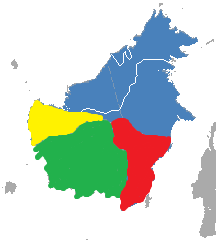Müller gibbon
| Müller gibbon | ||||||||||||
|---|---|---|---|---|---|---|---|---|---|---|---|---|

Muller gibbon ( Hylobates muelleri ) |
||||||||||||
| Systematics | ||||||||||||
|
||||||||||||
| Scientific name | ||||||||||||
| Hylobates muelleri | ||||||||||||
| Martin , 1841 |
The Müller-Gibbon ( Hylobates muelleri ) is an on Borneo endemic primate species from the family of gibbons (Hylobatidae).
distribution

Red - Müller gibbon,
blue - Eastern Borneo gibbon ,
yellow - Western Borneo gibbon ,
green - white beard gibbon
It occurs in the southeast of the island south of the Mahakam River and east of the Barito River. The distribution area thus roughly covers the Indonesian province of Kalimantan Selatan and the southern half of Kalimantan Timur .
features
The Müller gibbon reaches a weight of 4.6 to 6.2 kg (females) or 5 to 6.8 kg (males) and a head-trunk length of a little more than 40 cm. It is mouse-gray or brown in color, has a dark cap, a dark face and a dark chest, which vary individually depending on the age and animal. Males differ from females by a pale, often incomplete face ring and a dark brown cap (females have a black cap). The hair on the top of the head runs in a fan shape from the forehead to the back and is significantly longer above the ears.
Habitat and way of life
The monkey species lives in primary and secondary deciduous forests, monsoon forests, and tropical evergreen forests, often with high populations of wing fruit plants . It can also survive in selectively cleared forests, provided there are enough fruit-bearing trees left. Müller gibbons are diurnal tree dwellers and fruit eaters (62%), but also feed on young leaves (24%), flowers (13%) and insects (1%). Orange-colored fruits with juicy pulp, thin skin and small seeds are preferred, red or purple-colored to blackish fruits with dry pulp and large seeds (more than 20 mm ø) are avoided. If there are not enough fruits available, especially flowers will be eaten if there are enough available. A group usually consists of 3–4 animals, a female, a male and their offspring. Detailed research on reproduction has not yet been carried out for this species.
Systematics
The Müller gibbon was first described in 1841 by the English naturalist William Charles Martin . For a long time the western Borneo gibbon ( Hylobates abbotti ) and the eastern Borneo gibbon ( H. funereus ) were considered subspecies of Hylobates muelleri . According to recent morphological and genetic studies, however, these are separate species. The distribution areas of the four gibbon species on Borneo overlap at the edges. In the upper river basin of the Barito in central Borneo, hybrids between the Müller gibbon and the white-bearded gibbon ( H. albibarbis ) live in an area of about 5000 km² . The hybridization took place 5000 to 10,000 years ago and serves some scientists as an argument to consider the Müller gibbon and the whitebeard gibbon as conspecific species. Cases of polygyny are known among hybrids , while gibbons are usually monogamous .
Danger
The Müller Gibbon is classified by the IUCN as "endangered" (highly endangered). Over the past 45 years, the stock has decreased by 50%.
literature
- David J. Chivers, Martina V. Anandam, Colin P. Groves, Sanjay Molur, Benjamin M. Rawson, Matthew C. Richardson, Christian Roos & Danielle Whittaker: Family Hylobatidae (Gibbons). Page 784 in Russell A. Mittermeier , Anthony B. Rylands & Don E. Wilson : Handbook of the Mammals of the World: - Volume 3. Primates. Lynx Editions, 2013 ISBN 978-84-96553-89-7
Individual evidence
- ↑ Hylobates muelleri in the endangered Red List species the IUCN 2008. Posted by: Geissmann, T. & Nijman, V., 2008. Accessed May 30, 2016th